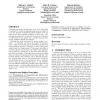Free Online Productivity Tools
i2Speak
i2Symbol
i2OCR
iTex2Img
iWeb2Print
iWeb2Shot
i2Type
iPdf2Split
iPdf2Merge
i2Bopomofo
i2Arabic
i2Style
i2Image
i2PDF
iLatex2Rtf
Sci2ools
CCS
2008
ACM
2008
ACM
Private combinatorial group testing
Combinatorial group testing, given a set C of individuals ("customers"), consists of applying group tests on subsets of C for the purpose of identifying which members of C are infected (or, more generally, defective in some way). The outcome of a group test reveals only the presence or absence of infection(s) in that group, but a number of group tests exactly identifies all infected members. Although the main motivation for group testing is economic
| Added | 12 Oct 2010 |
| Updated | 12 Oct 2010 |
| Type | Conference |
| Year | 2008 |
| Where | CCS |
| Authors | Mikhail J. Atallah, Keith B. Frikken, Marina Blanton, YounSun Cho |
Comments (0)

